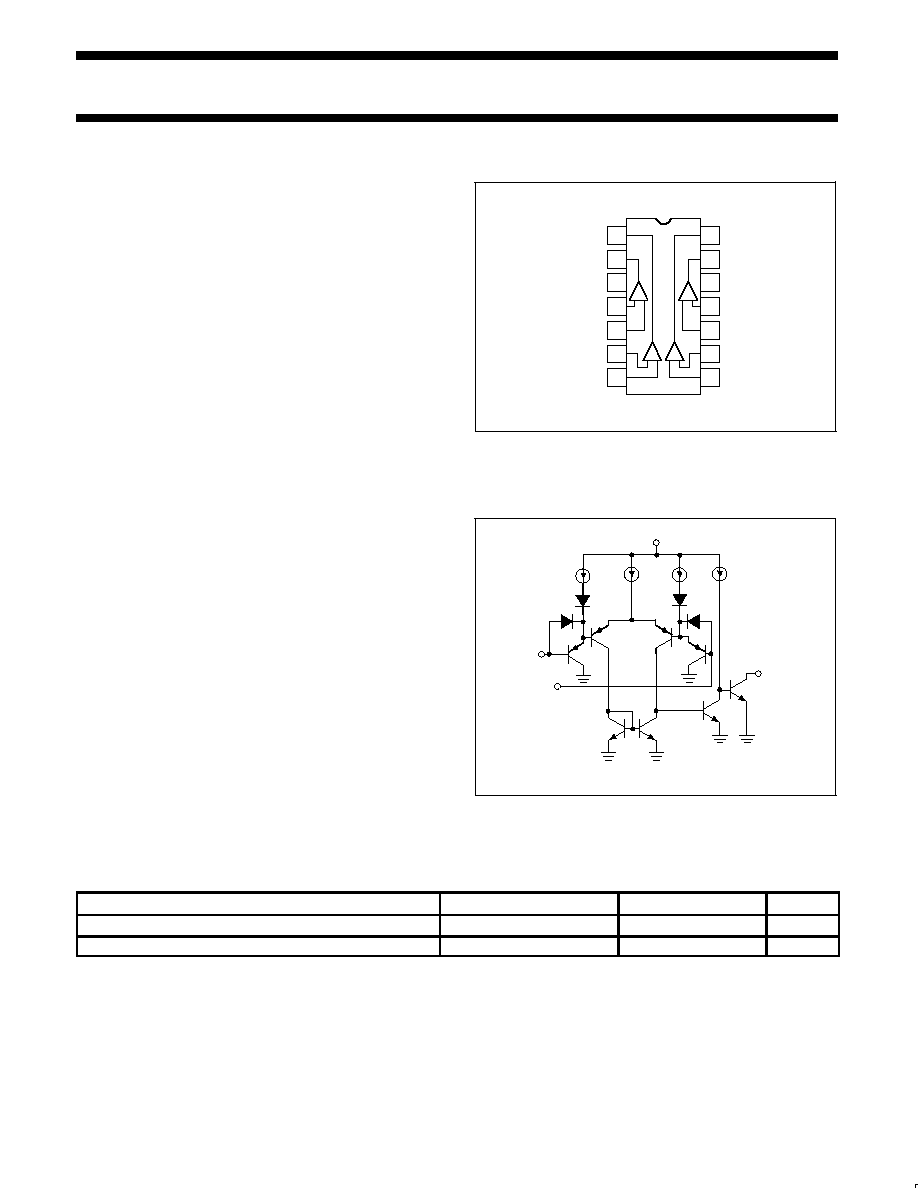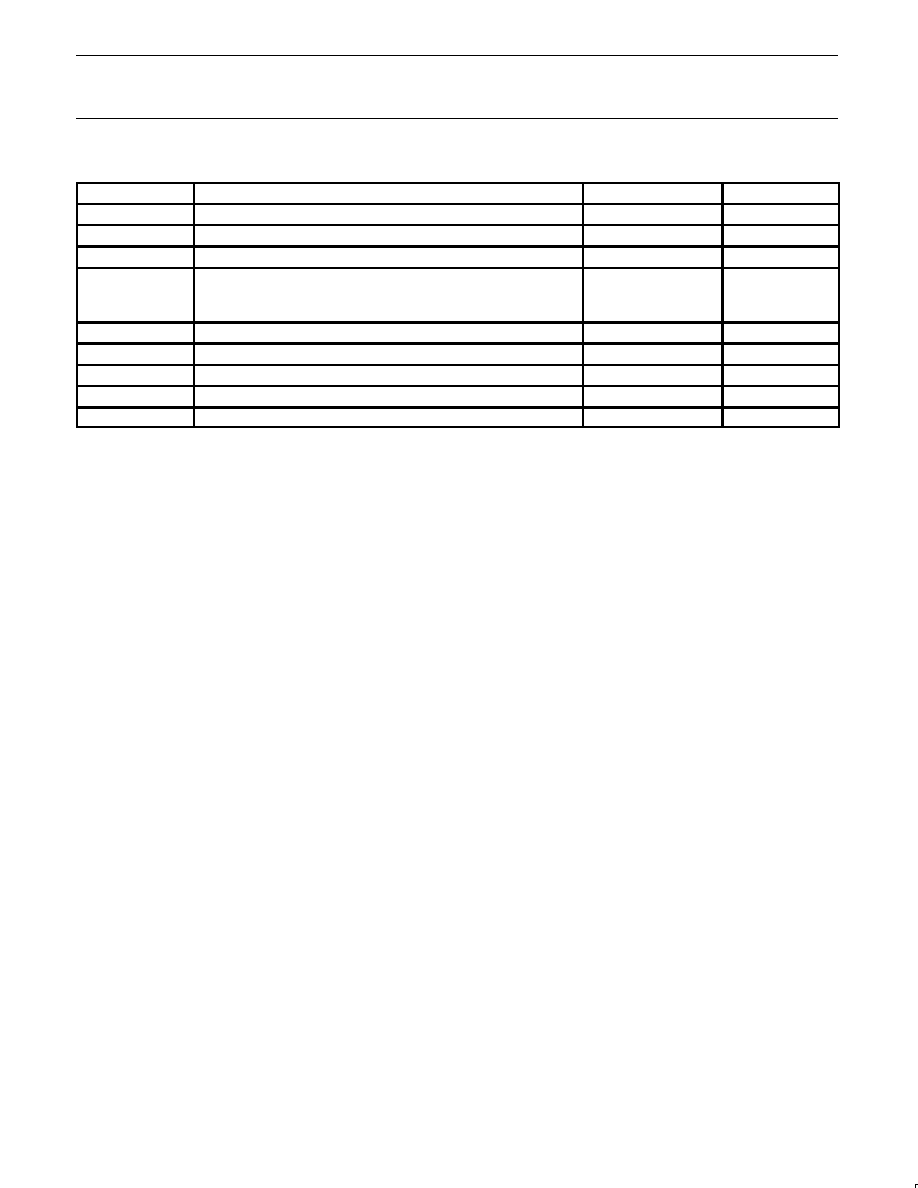 | –≠–ª–µ–∫—Ç—Ä–æ–Ω–Ω—ã–π –∫–æ–º–ø–æ–Ω–µ–Ω—Ç: AU2901 | –°–∫–∞—á–∞—Ç—å:  PDF PDF  ZIP ZIP |
Document Outline
- DESCRIPTION
- FEATURES
- APPLICATIONS
- ORDERING INFORMATION
- PIN CONFIGURATION
- EQUIVALENT CIRCUIT
- ABSOLUTE MAXIMUM RATINGS
- ELECTRICAL CHARACTERISTICS
- EQUIVALENT CIRCUIT
- TYPICAL PERFORMANCE CHARACTERISTICS
- PACKAGE
- Data sheet status
- Definitions
- Disclaimers

Philips
Semiconductors
AU2901
Quad voltage comparator
Product data
Supersedes data of 1994 Aug 31
File under Integrated Circuits, IC11 Handbook
2001 Aug 03
INTEGRATED CIRCUITS

Philips Semiconductors
Product data
AU2901
Quad voltage comparator
2
2001 Aug 03
853-1637 26837
DESCRIPTION
The AU2901 consists of four independent precision voltage
comparators, with an offset voltage specification as low as 2.0 mV
max for each comparator, which were designed specifically to
operate from a single power supply over a wide range of voltages.
Operation from split power supplies is also possible and the low
power supply current drain is independent of the magnitude of the
power supply voltage. These comparators also have a unique
characteristic in that the input common-mode voltage range includes
ground, even though they are operated from a single power supply
voltage.
The AU2901 was designed to directly interface with TTL and CMOS.
When operated from both plus and minus power supplies, the
AU2901 will directly interface with MOS logic where their low power
drain is a distinct advantage over standard comparators.
FEATURES
∑
Wide single supply voltage range 2.0 V
DC
to 36 V
DC
or dual
supplies
±
1.0 V
DC
to
±
18 V
DC
∑
Very low supply current drain (0.8 mA) independent of supply
voltage (1.0 mW/comparator at 5.0 V
DC
)
∑
Low input biasing current 25 nA
∑
Low input offset current
±
5 nA and offset voltage
∑
Input common-mode voltage range includes ground
∑
Differential input voltage range equal to the power supply voltage
∑
Low output 250 mV at 4 mA saturation voltage
∑
Output voltage compatible with TTL, DTL, ECL, MOS and CMOS
logic systems
APPLICATIONS
∑
A/D converters
∑
Wide range VCO
∑
MOS clock generator
∑
High voltage logic gate
∑
Multivibrators
PIN CONFIGURATION
1
2
3
4
5
6
7
8
14
13
12
11
10
9
OUTPUT 2
OUTPUT 1
V+
INPUT 1 ≠
INPUT 1 +
OUTPUT 3
TOP VIEW
D, N Packages
INPUT 1 ≠
INPUT 1 +
OUTPUT 4
GND
INPUT 4 ≠
INPUT 3 +
INPUT 3 ≠
INPUT 4 +
1
2
3
4
SL00106
Figure 1. Pin Configuration
EQUIVALENT CIRCUIT
V +
100
µ
A
3.5
µ
A
3.5
µ
A
100
µ
A
Q1
Q2
Q3
Q4
Q8
Q7
Q6
Q5
≠ INPUT
OUTPUT
+ INPUT
(One Comparator Only)
SL000107
Figure 2. Equivalent Circuit
ORDERING INFORMATION
DESCRIPTION
TEMPERATURE RANGE
ORDER CODE
DWG #
14-Pin Plastic Small Outline (SO) Package
≠40
∞
C to +125
∞
C
AU2901D
SOT108-1
14-Pin Plastic Dual In-Line Package (DIP)
≠40
∞
C to +125
∞
C
AU2901N
SOT27-1

Philips Semiconductors
Product data
AU2901
Quad voltage comparator
2001 Aug 03
3
ABSOLUTE MAXIMUM RATINGS
SYMBOL
PARAMETER
RATING
UNIT
V
CC
V
CC
supply voltage
36 or
±
18
V
DC
V
DIFF
Differential input voltage
36
V
DC
V
IN
Input voltage
≠0.3 to +36
V
DC
P
DMAX
Maximum power dissipation, T
amb
= 25
∞
C (still-air)
1
N package
1420
mW
D package
1040
mW
Output short-circuit to ground
2
Continuous
I
IN
Input current (V
IN
< ≠0.3 V
DC
)
3
50
mA
T
amb
Operating temperature range
≠40 to +125
∞
C
T
stg
Storage temperature range
≠65 to +150
∞
C
T
sld
Lead soldering temperature (10 sec max)
230
∞
C
NOTES:
1. Derate above 25
∞
C, at the following rates:
N Package at 11.4 mW/
∞
C
D Package at 8.3 mW/
∞
C
2. Short circuits from the output to V+ can cause excessive heating and eventual destruction. The maximum output current is approximately
20 mA independent of the magnitude of V+.
3. This input current will only exist when the voltage at any of the input leads is driven negative. It is due to the collector-base junction of the
input PNP transistors becoming forward biased and thereby acting as input diode clamps. In addition to this diode action, there is also
lateral NPN parasitic transistor action on the IC chip. This transistor action can cause the output voltages of the comparators to go to the V+
voltage level (or to ground for a large overdrive) for the time duration that an input is driven negative. This is not destructive and normal
output states will reestablish when the input voltage, which was negative, again returns to a value greater than ≠0.3 V
DC
.

Philips Semiconductors
Product data
AU2901
Quad voltage comparator
2001 Aug 03
4
ELECTRICAL CHARACTERISTICS
V+ = 5 V
DC;
≠40
∞
C
T
amb
125
∞
C, unless otherwise specified.
SYMBOL
PARAMETER
TEST CONDITIONS
Limits
UNIT
SYMBOL
PARAMETER
TEST CONDITIONS
Min
Typ
Max
UNIT
V
OS
Input offset voltage
2
T
amb
= 25
∞
C
±
2.0
±
3
mV
V
OS
In ut offset voltage
Over temp.
±
2.5
±
5
mV
V
CM
Input common-mode voltage range
3
T
amb
= 25
∞
C
0
V+ ≠1.5
V
V
CM
In ut common-mode voltage range
Over temp.
0
V+ ≠2.0
V
V
IDR
Differential input voltage
1
Keep all V
IN
s
0V
DC
(or V≠ if need)
V+
V
4
I
IN(+)
or I
IN(≠)
with output in linear range
I
BIAS
Input bias current
4
T
amb
= 25
∞
C
25
250
nA
Over temp.
200
500
I
IN(+)
≠ I
IN(≠)
I
OS
Input offset current
T
amb
= 25
∞
C
±
5
±
50
nA
Over temp.
±
50
±
200
nA
I
OL
Output sink current
V
IN(≠)
1 V
DC
; V
IN
(+) = 0; V
O
1.5 V
DC
;
T
amb
= 25
∞
C
6.0
16
mA
V
IN(+)
1 V
DC
; V
IN
(≠) = 0
I
OH
Output leakage current
V
O
= 5 V
DC
; T
amb
= 25
∞
C
0.1
nA
V
O
= 30 V
DC
; Over temp.
1.0
µ
A
R
L
=
on comparators,
I
CC
Supply current
T
amb
= 25
∞
C
0.8
2.0
mA
V+ = 30 V
1.0
2.5
A
V
Voltage gain
R
L
15 k
; V+ = 15 V
DC
25
100
V/mV
V
IN(≠)
1 V
DC
; V
IN(+)
= 0; I
SINK
4 mA
V
OL
Saturation voltage
T
amb
= 25
∞
C
400
mV
Over temp.
400
700
t
S
Large signal response time
V
IN
= TTL logic swing; V
REF
= 1.4V
DC
;
300
ns
t
LSR
Large≠signal response time
IN
g
g
REF
DC
V
RL
= 5V
DC
; R
L
= 5.1 k
; T
amb
= 25
∞
C
300
ns
t
R
Response time
5
V
RL
= 5 V
DC
; R
L
= 5.1 k
; T
amb
= 25
∞
C
1.3
µ
s
NOTES:
1. Positive excursions of input voltage may exceed the power supply level by 17 V. As long as the other voltage remains within the
common-mode range, the comparator will provide a proper output state. The low input voltage state must not be less than ≠0.3 V
DC
(or
0.3 V
DC
below the magnitude of the negative power supply, if used).
2. At output switch point, V
O
1.4 V
DC
, R
S
= 0
with V+ from 5 V
DC
to 30 V
DC
; and over the full input common-mode range (0 V
DC
to
V+ ≠ 1.5 V
DC
).
3. The input common-mode voltage or either input signal voltage should not be allowed to go negative by more than 0.3 V. The upper end of
the common-mode voltage range is V+ ≠ 1.5 V, but either or both inputs can go to 30 V
DC
without damage.
4. The direction of the input current is out of the IC due to the PNP input stage. This current is essentially constant, independent of the state of
the output so no loading change exists on the reference or input lines.
5. The response time specified is for a 100 mV input step with a 5 mV overdrive. For larger overdrive signals, 300 ns can be obtained (see
Typical Performance Characteristics section).

Philips Semiconductors
Product data
AU2901
Quad voltage comparator
2001 Aug 03
5
EQUIVALENT CIRCUIT
100 k
500 pF
10
0.1
µ
F
20 k
50 k
20 k
V + /2
V +
30 k
5.1 k
700 k
V ≠ /2
≠
+
+ VC
FREQUENCY
CONTROL
VOLTAGE
INPUT
3.0 k
OUTPUT 1
OUTPUT 2
≠
+
≠
+
+ VREF HI
+ VIN
2RS
RS
2RS
+ V (12 VDC)
10K
LAMP
2N2222
+
≠
+
≠
+
≠
+ 5 VDC
360
100
100 k
+
≠
+ 5 VDC
360
100
+
≠
+ 5 VDC
360
100
+
≠
+ 5 VDC
360
100
+ VREF 4
+ VREF 3
+ VREF 2
+ VREF 1
VO
+
≠
V+
2.0 k
V+
0
VO
1 ≠ 100 kHz
CRYSTAL
200 k
200 k
100 k
0.1
µ
F
Crystal-Controlled Oscillator
Limit Comparator
Two≠Decade High≠Frequency VCO
Visible Voltage Indicator
+
≠
TTL-to-MOS Logic Converter
NOTES:
V+ = 30 VDC
+ 250 m VDC < VC
50 VDC
700 H < fO = 100 kHz
NOTE:
Input of unused comparators should be grounded.
1/4AU2901
+VREF LOW
V+
0.01
µ
F
5 VDC
+VREF
1.4 VDC
10 k
VO
o
≠12 V
≠12 VDC
SL00108
100 k
100 k
100 k
Figure 3. Equivalent Circuit




